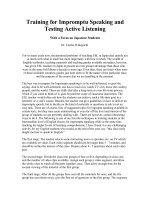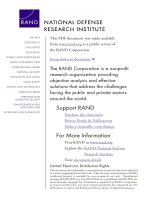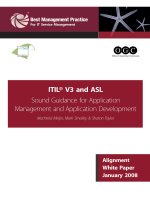Training for Impromptu Speaking and Testing Active Listening
Bạn đang xem bản rút gọn của tài liệu. Xem và tải ngay bản đầy đủ của tài liệu tại đây (55.4 KB, 2 trang )
Training for Impromptu Speaking and
Testing Active Listening
With a Focus on Japanese Students
Dr. Cecilia B-Ikeguchi
For so many years now, the perennial problems of teaching ESL in Japan deal mainly not
so much with what to teach but more importanty with how to teach. The wealth of English
textbooks, teaching materials and teaching guides available nowadays, however, has given
ESL teachers in Japan at present an even greater advantage than those who were in the
same field about a decade or more ago. Even then, there are times when none of these
available countless guides just dont seem to fit the nature of the particular class and the
purpose of the course that we are handling at the moment.
The best way to prepare for Impromptu speaking is to be well-informed, so goes the
saying. And to be well-informed, one has to read a lot, watch TV a lot, know the country,
people, and the world. These are skills that take a long-term or even life-term process,
which if you come to think of it, goes beyond the scope of classroom instruction. The ESL
teacher would often ask how the students can achieve such a life-time goal in a semester or
a year's course. Besides, the teacher can give guidelines on how to deliver an impromptu
speech, but to decide on the kind of materials or questions to ask is not an easy task. There
are of course, lists of suggested topics for improptu speaking available in certain texts, but
they may seem uninteresting or even far off the level and interest of the group of students
we are presently dealing with . There are however, certain interesting ways to do it. The
following is one of my favorite techniques in training students in the Intermediate level of
English classes for impromptu speaking while at the same time teaching the higher levels
of listening comprehension. I have found it a very challenging activity for my English
students who would, at the end of the year, say: "this class realy taught me how to speak in
English."
The first stage: The teacher selects some interesting news or episodes, etc. on TV which are
available on video. Each video segment should not be longer than 5 - 7 minutes, and should
be within the interest of the class. Prepare about 4 - 5 questions about each video part.
The second stage: Divide the class into groups of four or five, depending on class size, and
the number of video clips available. Assign each group a video segment, and allow the
whole class to watch all the parts together, once. Then allow enough time for the second
viewing of the material of the first group.
The third stage: After all the groups have seen all the materials for once, and the firs group
has seen theirs twice, give the first set of questions to the first group. The sequence of
group performance can be decided on by lottery, or at random by the teacher. Assign each
student in the group a question at random. While the first group is engaged in impromptu
speaking, the rest of the class are watching their assigned video segment for the second
time. The length of each video segment should be controlled so that when the first group
finishes their speech, the next will be called in to present, and the other groups are ready to
watch theirs for the second time. Meanwhile the first group to finish will now join wathing
the speeches of the second group, and the audience increases as the number of groups to
finish increases.
The fourth and final stage: When everybody is back into the big class group, students are
then ready to ask questions, by being encouraged to do so or being assigned beforehand,
about things they did not fully understand in the other groups video segments and which
they find interesting.
What are the advantages of this technique? First, materials for imprompu speaking are
chosen by the teacher according to the students' interest level, rather than picking out topics
from text materials, etc. Not only that, this activity combines training students for public
speaking and testing comprehension of materials presented through visuals. Furthermore,
the students are simultaneously engaged in different activities instead of getting bored
listening to all the classmates' speeches. Finally, the class is given a chance to watch a
variety of materials - although short - in a limited class time. By providing a number of
topics that will most likely hit the different interest levels of students in the same class, the
students are driven, by their own interest to ask questions and finally, be engaged in
meaningful conversations.









